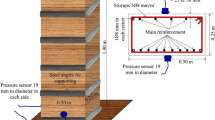Abstract
In this paper, several current industrial practices in formwork design are presented focusing on the normative calculation of the form pressure. Most of the current Standards are devoting for the design of the formwork for the normal vibrated concrete. Currently, the Standards are being updated to include provisions for the newly adapted concrete, such as the flowable concrete and self-consolidating concrete. However, the experience with these methods is still limited. The available methods for calculating the formwork pressure for the flowable concrete and SCC are based on measuring the shear strength of concrete using different concepts, such as the setting time of concrete or the structural build-up at rest. More field work is necessary to validate and provide the confidence to the available methods for the formwork pressure calculation. With this information the regulations could be improved to ensure a more economic formwork design. The paper was discussed within the RILEM TC 233-FPC “Form pressure generated by fresh concrete”.





Similar content being viewed by others
Notes
The load information in the following is intended for use with working stress design standards. When limit states design procedures are used, these loads must be taken as specified live loads and factored in accordance with the requirements of the applicable Standards.
Abbreviations
- a :
-
Spread in the flow-table test (mm)
- b, d :
-
Formwork dimensions (m)
- g :
-
Gravity constant (m/s2)
- h :
-
Distance from the concrete level to a certain location (m)
- h E :
-
Distance from the concrete level to the location where the concrete has achieved the final setting (m)
- h S :
-
Hydrostatic height corresponding to the maximum pressure (m)
- H (h):
-
Height of the casting section (m)
- s :
-
Slump (mm)
- T :
-
Concrete temperature (°C)
- t E :
-
Final setting time of the concrete (h)
- v (R):
-
Mean placing rate (m/h)
- V :
-
Variation coefficient (–)
- γ c (w):
-
Specific concrete weight (γc = ρc × g = density of the fresh concrete × gravity) (kN/m3)
- γ F :
-
Partial safety factor on the load (–)
- γ g :
-
Global safety factor (–)
- ρc :
-
Concrete density (g/cm3)
- σ h :
-
Horizontal (lateral) pressure of fresh concrete (kN/m2)
- σ hk,max (P max):
-
Maximum characteristic lateral pressure of fresh concrete (kN/m2)
References
ACI 347-04: Guide to Formwork for Concrete. American Concrete Institute (2004)
Proske T (2007) Frischbetondruck bei Verwendung von Selbstverdichtendem Beton—Ein wirklichkeitsnahes Modell zu Bestimmung der Einwirkungen auf Schalung und Rüstung, Dissertation (Formwork Pressure using Self-Compacting Concrete, Ph.D. Thesis), Technische Universität Darmstadt, p 310
Graubner C-A, Beitzel H, Beitzel M, Brameshuber W, Brunner M, Dehn F, Glowienka S, Hertle R, Huth J, Leitzbach O, Meyer L, Motzko Ch, Müller HS, Proske T, Rathfelder M, Schuon M, Uebachs S (2006) Sachstandsbericht Frischbetondruck fließfähiger Betone (State-of-the-Art-Report—Pressure on Formwork Generated by Highly Workable Concrete), Schriftenreihe des Deutschen Ausschusses für Stahlbeton, Heft 567. Beuth Verlag, Berlin, p 75
CIB-CEB-FIB-Bulletin: Manual de Technologie Coffrage. établi par un Groupe Inter-Associations CIB-CEB-FIB (1977)
CIRIA Research Report Nr. 108: The pressure of concrete in formwork. Clear CA, Harrison TA, Construction Industry Research and Information Association, London (1985)
DIN 18218:1980-09: Frischbetondruck auf lotrechte Schalungen (Pressure of Fresh Concrete on Vertical Formwork), Beuth Verlag (1980)
IS 14687:1999: Guidelines for falsework for concrete structures, Indian Standard, New Delhi (1999)
JGJ 162-2008: Technical code for safety of forms in construction, People’s Republic of China (2008)
NF P 93-350: Banches industrialisées pour ouvrages en betón, Paris, Juni (1995)
TGL 33421/01: Betonbau; Schalverfahren, Standschalungen (Making of Concrete, Preparation of fresh Concrete). Staatsverlag der DDR, Berlin (1977)
Rodin S (1952) Pressure of concrete on formwork. In: Proceedings, Institution of Civil Engineers, Vol. 1, pp 709–746
Gardner NJ (1985) Pressure of concrete on formwork: a review. In: Proceedings, American Concrete Institute, vol. 82, pp 744–753
Graubner CA, Boska E, Motzko C, Proske T, Dehn F (2012) Formwork pressure induced by highly flowable concrete—design approach and transfer in practice. Structural concrete, journal of the fib. Ernst & Sohn Verlag, Berlin
Gardner J, Keller L, Quattrociocchi R, Charitou G (2012) Field Investigation of Formwork Pressures using Self Consolidating Concrete, Concrete International, Vol. 34, No. 1, pp 41–47
Kayat KH, Omran AF (2011) Field verification of formwork pressure prediction models. Concr Int 33(6):33–39
Lange D (2008) How tall, how fast, how safe? New insights into form-work pressure of self-consolidating concrete. Concr Constr 2008:33–36
DIN Standard on Formwork Pressures Updated (2010) Concr Int 32(6):27–29
DIN 18218:2010-01: Pressure of fresh concrete on vertical formwork—English translation of DIN 18218:2010-01, Beuth Verlag (2010)
Graubner C-A, Beitzel H, Beitzel M, Bohnemann C, Boska E, Brameshuber W, Dehn F, König A, Lingemann J, Motzko C, Müller HS, Pistol K, Proske T, Stettner C, Zilch K (2008) Schalungsbelastung durch Hochleistungsbetone mit fließfähiger Konsistenz—Ein Gemeinschaftsprojekt deutscher Forschungseinrichtungen—Abschlussbericht. (Final Report) F09-7-2008, TU Darmstadt, Institut für Massivbau
Omran AF, Naji S, Khayat KH (2011) Portable vane test to assess structural build-up at rest of self-consolidating concrete. ACI Mater J 108(6):628–637
Khayat KH, Omran AF, Pavate T (2010) Inclined plane test method to determine structural build-up at rest of self-consolidating concrete. ACI Mater J 107(5):515–522
Gardner NJ (1985) Pressure of concrete on formwork—a review. In: ACI Journal Proceedings, V. 82, No. 5, pp 744–753
GSV Guidelines: Important information regarding the intended use and safe application of formwork and falsework. Güteschutzverband Betonschalungen e. V. (2009)
Author information
Authors and Affiliations
Corresponding author
Rights and permissions
About this article
Cite this article
Proske, T., Khayat, K.H., Omran, A. et al. Form pressure generated by fresh concrete: a review about practice in formwork design. Mater Struct 47, 1099–1113 (2014). https://doi.org/10.1617/s11527-014-0274-y
Received:
Accepted:
Published:
Issue Date:
DOI: https://doi.org/10.1617/s11527-014-0274-y




